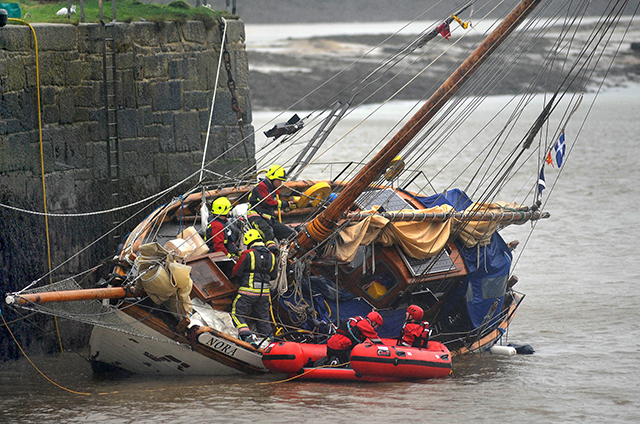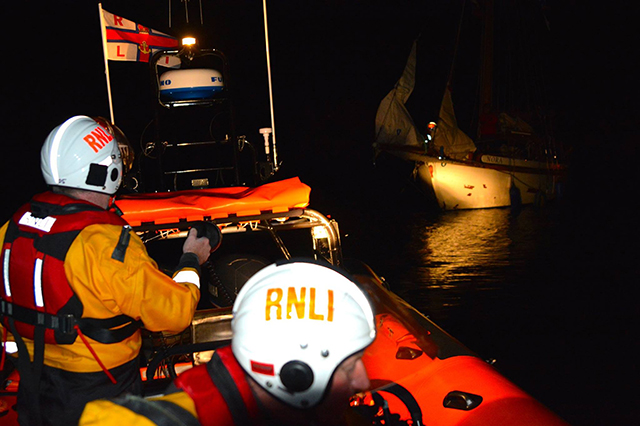American yachtsman Steve Shapiro defends his haphazard voyage, while others call for him to be stopped.
The skipper of the American yacht Nora says their ‘nine rescues in seven months’ is ‘grossly exaggerated.
Steve Shapiro, aged 71, says it’s really three emergency callouts and the rest were just friendly assistances by lifeboat volunteers passing by.
Steve, who sails the 40ft Colin Archer gaff cutter with crew Bob Weise, a retired lieutenant colonel army pilot – also in his 70s, is responding to calls that they should abandon their voyage from Scandinavia to North America after prompting lifeboats callouts in Norway, Scotland, Ireland and Cornwall since setting sail last July.
Round-the-world yachtsman Sir Robin Knox-Johnston is the biggest name to urge the pair to give up, saying: ‘This is no longer a joke.
‘It costs between £6,000 and £8,000 every time a lifeboat is launched. These guys are costing the RNLI a fortune.
‘They need to frankly pack it in.’

The yacht Nora tilted over at Hayle Harbour. Credit: COLIN HIGGS/APEX
Following Nora’s most recent assistance by the St Ives All Weather Lifeboat on 19 January when the yacht had ‘no propulsion’, Steve and Bob are currently moored up at Hayle Harbour, Cornwall, where on Tuesday, 26 January, a fire caused cosmetic damage to the boat – after an unattended candle ‘reignited’ and set a pile of clothes alight when the boat tilted on its moorings.
Steve said: ‘Structurally the boat is ok, cosmetically it’s going to need some work.
‘The fire on board was certainly an extreme problem but there’s always something to do on a wooden boat.’
Steve told PBO that after his wife and mother died, he decided to embark on a voyage that had long been a dream. He bought Nora in Norway and aims to sail her back to his home in Maine in the United States of America.
Steve said: ‘It’s just very simple. I bought a boat in Norway and I’m sailing it home.
‘I’m not trying to set records or have an adventure, I’m just sailing my boat home.’
‘Grossly exaggerated’
Steve, who has been sailing since he was nine, described reports of Nora’s nine rescues as ‘grossly exaggerated.’
He said: ‘When we left Norway we had an accident where the boat went over fishing lines and the propeller shaft got caught – creating a hole.
‘We were taking on water and there was a leak. We had to be pulled out of the strong sea. We felt we were in danger, the rescue service eventually agreed. At first they said ‘you’re a sail boat – sail’ but we were under full sail and making two knots and needed to have the motor to get out of a six knot current.
‘We had to be towed back and sat on the harbour for nearly a month fixing the problem.
‘There was still a leak but it wasn’t as bad. They said with a good bilge pump we could probably go to Inverness where a better repair could be carried out.
‘We went across to the Shetland Islands, from there we went around the point of Wick. We wanted to pull over but didn’t go in the right place. We got a call on the radio, they said ‘Are you alright? We’re sending someone out to look at you as we heard you had problems.’
‘They came out and looked, sure enough there was a pretty bad leak. They wouldn’t let us go forward to Inverness, they said ‘The guy who fixes things is here.’
‘We pulled over for 10 days, had it fixed and sailed out.
‘We ran aground going into Helmsdale Harbour, which was noticeably not properly marked.
‘We sat there trying to get attention but the harbour master was out fishing.
‘The tide came back and ushered us off the rocky perch.’
Steve said after this, in the middle of the Moray Firth the engine transmission failed: ‘That was our third call out.’
The yacht was taken in tow by Wick and then Moray lifeboats to Invergordon.
Steve said: ‘People from Inverness drove up to look at the motor. We paid dearly for a private tow to Inverness and it was put on a dry dock while they did a very pricey repair.
‘Then we got everything fixed and went through The Caledonian Canal, on our way to Oban where I had to pick up a sail.
‘We ran into a category 9 storm and turned into Crinan. Then we had a lot of great sailing for about a week and a half.
‘We went from Mull of Kintyre across to Belfast, Ireland. We called the coastguard to get directions to a marina because when we’d left Inverness they said ‘be sure to keep in touch with the coastguard’.
‘We were trying to navigate around Red Bay for a place to find an overnight safe harbour.’
Aground at Red Bay
Steve said: ‘We ran aground on sand. A fisherman tried to pull us off with his big boat but he was unsuccessful. The lifeboat people, just 50ft away, decided to come off their perch to help us. They were unable to do anything different to the fishing boat. The water was very shallow and it was partially shifting sands.
‘A buoy marker wasn’t lit and it was a very dark night.
‘We had to wait on the sandbar until morning and then floated off.’
Their voyage along the Irish coast was stopped by a ‘devastating storm’ at the end of September. They then sailed on to Dún Laoghaire. At Wicklow they ran ‘aground for a couple of seconds.’
Steve said: ‘They decided to send a lifeboat to take us alongside.’
The pair set sail to Arklow the following day and stayed there for a couple of nights. ‘When the weather cleared to our satisfaction we headed to Tuskar Rock.
‘Out at sea there were 11ft waves and 24mph winds, we ended up as a spontaneous gesture pulling into Kilmore Quay. There were then nine named storms.
‘From there we finally had a weather window to sail around Land’s End. Because of the amount of storms the notably sandy entrance had filled in and the sand caught us again going out of Kilmore Quay harbour.
‘The lifeboat was about 10ft away so it pulled us off. The lifeboat then led us out the maze of sandbars.
‘A transit buoy had been unearthed during the storms so there really was no way to tell where to make the easterly turn.’
Steve said it was ‘like a pleasure cruise’ for the RNLI crew: ‘They were our pals by then, we’d been there for seven weeks and knew everyone around the harbour.’
In fair winds and following seas, the duo set sail but as they reached the Bristol Channel, the wind’s changed. They took shelter at St Ives, where Steve says they were told to tie up to the RNLI buoy.
He said the RNLI sent out a RIB and the crew led them to the mooring, kindly passing the mooring buoy and lines.
‘Not all rescues’
Steve said: ‘Some articles have counted those as rescues. All they did was pull us off a sandbar happily and escort us in very mild seas to the harbour gates, I think that’s a bad rap.’
Steve said at St Ives they could have used sails but the RNLI offered to help.
When St Ives needed its mooring buoy again, Nora was getting ready to move on to Hayle when ‘all of a sudden the power stopped’ so they were towed by the RNLI and two volunteer lifeboat crewmembers were put on board.
Steve said: ‘We came into the dry harbour and didn’t tie up properly so we had problems as the boat was listing and a candle reignited itself and burnt my mate’s clothing.’
‘Under control’
In total, Steve believes he and Bob have spent five months of their seven-month voyage enjoying ‘very pleasant sailing’.
‘I think buying a brand new boat has meant a lack of familiarity. It was more worn than advertised. We’ve brought it up to date and made repairs.
‘I don’t fault my seamanship and there’s no way anyone else could.
‘They advised us to be in touch and to call for assistance.
‘Only three were really distressed calls and those were at the beginning of the journey, then we had things under control. Even if the boat was broken we could’ve fixed it, it’s very seaworthy.
‘It’s kind of messy with two guys on board, we’re not the cleanest things in the world.
‘In all reality the criticism is not fair, they weren’t emergency, life or death calls.
‘The rescuers are there for anybody without prejudice.
‘They weren’t dangerous callouts except for one in the North Sea, all the others didn’t demand anything more than routine training.’
Steve added: ‘I don’t make light of it, we’re very grateful for them being there and I’m very appreciative.’
What’s next?
‘We have to wait for the winds to calm down, which is predicted a week and a half away.’
Steve said the highlights of the trip so far had been ‘crossing the North Sea and meeting all the people.’
He said the kindness of people in the Royal Standard Inn at Hayle had brought him ‘to tears.’
Nora yacht ‘should be detained’

Hayle Harbour
Hayle Harbour Master Peter Haddock, where the 40ft yacht is currently situated, believes Nora should be detained by the UK Coastguard.
He said: ‘It’s for the coastguard to decide if the boat is to be detained, I fear for the crew safety and for I fear for the safety of the guys who have got to go out and sort them out every time.
‘I’d be very surprised if they made it across the Atlantic, it’s been a disaster ever since they left Scandinavia. There have been nine rescues since then.‘They’re oblivious to danger and to the problems they’ve created, it’s really frightening.’
The MAIB have been informed about the fire and a report submitted.
A spokeswoman for the Maritime and Coastguard Agency said: ‘We have not been made aware of any grounds that would lead to detaining this vessel.’
Multiple rescue yacht Nora catches on fire
The American yacht Nora, which has been rescued multiple times since setting sail last July, has been damaged by a…
Coastguard warning after two yachtsmen spark multiple rescues
"It’s not of role the UK Coastguard, which is an emergency service, to arrange a vessel’s repairs or to move…






